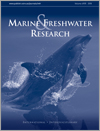Marine and Freshwater Research
Volume 69
Number 9 2018
We evaluated control of redfin perch in Lake Purrumbete, Australia. Removal strategies that exploit small adult fish with high levels of effort on an annual time scale resulted in the greatest reduction in undesirable fish and the greatest increase in large desirable fish while maintaining population stability. This result can help refine removal strategies in Lake Purrumbete to achieve more desirable fishery characteristics.
This study provides the first age and growth information of blue sharks in the central South Pacific based on observers’ data. These results could help reduce the uncertainty in future stock assessment. Blue sharks in this region grow faster and have younger maximum ages (15 years for males and 11 years for females) than those in the South-west Pacific.
This study presents the first robust estimates of abundance and demographic parameters of common bottlenose dolphins in a highly affected coastal ecosystem along the north-eastern Atlantic. Using mark–recapture techniques, the findings suggest seasonal fluctuations in abundance and emigration rates related to changes in the availability and abundance of prey species in the area.
In February 2013, a large group of the rarely encountered Lusitanian cownose rays was accidentally caught in the eastern Mediterranean Sea. The location of the catch and the reproductive status of the fish suggest that the region may be a nursery area. The results of the study provide new information on this near-threatened species, of which little has been previously recorded in the Mediterranean.
A field study in Sarıçay Stream, Turkey showed that native mussels and artificial mussels take up different kinds and forms of metals from the water. Therefore, both native mussels and artificial mussels should be used in future pollution monitoring in order to provide complementary information and a better coverage of different kinds and forms of metals in the environment.
Galaxias platei presents annual spawning during the austral autumn. Its reproductive cycle is related to the deep-strata water temperature where it lives. Delayed maturity, maximum body size and egg size indicate that this species is more specialised than other Patagonian Galaxias in terms of lifestyle. These specialised features are consistent with a stable environment, such as the deeper strata.
We investigated the resistance of Physa acuta to desiccation and its behavioural responses (horizontal migrations and burrowing) to drying. We observed physiological tolerance as well as behavioural adaptations (horizontal migration) of P. acuta to decreases in water level and substratum drying. These findings are especially important because this species is globally invasive and the observed adaptations may facilitate its spread.
The increasing conversion of native forest to pasture lands for cattle breeding has led to a quantitative and qualitative change of organic-matter input into aquatic ecosystems, and, thus, in nutrient cycling. However, the effect of such changes are poorly studied, especially for C4 grasses, which are usually considered as a poor source of nutrients. Our results support the observation that the replacement of riparian vegetation in tropical forest alters breakdown rates and nutrient distribution, which may disrupt aquatic food webs.
In the absence of historical data, macrofossils from surface sediment may provide highly relevant information concerning modern and past assemblages in Mediterranean ponds. Herein we explore the correspondence between contemporary macrophyte assemblages and their sedimentary remains, showing that macrofossils may be useful sedimentary proxies for reconstructing both their contemporary source communities and the environmental forces controlling their assemblage composition.
This study explored the seasonal distribution of nutrients in six rivers, with different tidal ranges, along the west coast of India. The rivers with microtidal range acted as nutrient traps compared with the mesotidal rivers. Coastal geomorphology was found to play a major role in affecting the water quality of the rivers.
This study investigated the importance of shredder density and leaf litter identity on leaf litter decomposition in the Azores Archipelago. We show that when shredders are present at high densities in oceanic island streams they can substantially contribute to the decomposition of high-quality leaf litter, whereas the decomposition of hard leaf litter is mostly performed by the microbial community.
Sharks are traditionally aged by counting alternating light and dark bands that comprise the vertebrae. However, we find that vertebral counts correlate more closely with body shape and size parameters and differ along the length of the body. We suggest that band pair deposition corresponds to growth rather than age: a serious implication for the conservation and management of sharks.
Spatiotemporal variation in food web structure in the upper Yeşilırmak River, Anatolia Peninsula, Turkey, in relation to environmental parameters and a dam was examined using stable isotope analysis. Fish assemblages from different sites and seasons occupied distinct areas of isotopic space and trophic diversity. The findings strongly suggest that the dam affects environmental conditions, fish diversity and trophic ecology.
Picocyanobacteria are indisputably among the key components of marine planktonic systems, being responsible for the major fraction of ocean primary production. Most research about functional aspects of ocean ecosystems has focused on this group. However, their allelopathic properties, which may play a role in their community interactions, have only been studied recently. This study increases our knowledge of this phenomenon with competitor microalgae.
This study examined differences in body morphology in largemouth bass (Micropterus salmoides) between two states in north-eastern United States. We found differences in jaw length and caudal peduncle fin depth between populations in the two states. We suggest that this is mainly due to latitudinal variation, and that body morphology is influenced by a complex array of environmental factors, even at a small latitudinal scale.




